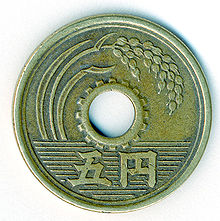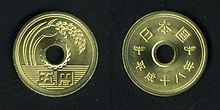5 yen coin
| Japan | |
| Value | 5 Japanese yen |
|---|---|
| Mass | 3.75 g |
| Diameter | 22 mm |
| Thickness | 1.5 mm |
| Center hole diameter | 5 mm |
| Composition | c. 65% Cu c. 35% Zn |
| Years of minting | 1948–1958 (Old style) 1959–present (New style) |
| Catalog number | KM 72, 72a, 96.1 and 96.2 |
| Obverse | |
 |
|
| Design | Rice ,water and gear |
| Designer | "Old script" |
| Reverse | |
 |
|
| Design | Tree sprouts |
| Designer | "new script" |
The 5 yen coin (五円硬貨 Go-en kōka?) is one denomination of Japanese yen. The current design was first minted in 1959 using Japanese characters known as the "new script", and were also minted from 1948-1958 using "old-script" Japanese characters. Five-yen coins date to 1870 (when, due to the much higher value of the yen, they were minted in gold). The modern-day coin was first produced in 1948 with a different styled inscription. This was changed in 1959 and the design has remained unchanged since.
The front of the coin depicts a rice plant growing out of the water, with "five yen" written in kanji; the back is stamped with "Japan" and the year of issue, also in kanji, separated by sprouts of a tree. The three graphic elements of the coin represent agriculture and fisheries, the key elements of the Japanese first-sector economy. Around a hole, there is a gear that represents industry. It is the only Japanese coin in circulation to lack Arabic numerals on either face.
The Japanese for "five yen," go en (五円) is a homophone with go-en (御縁), "en" being a word for causal connection or relationship, and "go" being a respectful prefix. As a result, five-yen coins are commonly given as donations at Shinto shrines with the intention of establishing a good connection with the deity of the shrine, and is widely believed it is best to insert a single five-yen coin into a new wallet before inserting any other money.
Following the nuclear accident at Tokai, Ibaraki in 1999, physicists Masuchika Kohno and Yoshinobu Koizumi showed how this coin could be used to estimate neutron dosage to the surrounding population, by measuring its zinc isotope ratios. They write:
...
Wikipedia
